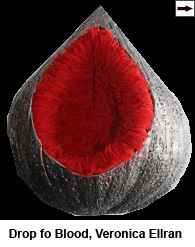Lectures on Sensory Transduction, Flexible Mind and Spacial Perception without Vision
With the participation of
Shani Shapira, brain researcher from the laboratory of Prof. Amir Amedi - The Hebrew University of Jerusalem,
Noam Glikfeld, architect, lecturer at the Technion
Keren Yaffe, Director of Tel Aviv Multi Service Center for the Blind
Veronica Ellran, promotor and founder of the project "Sense the Art”
The researcher Shani Shapira lectured on the subject of Sensory Transduction, the Fexible Mind and introduced the Eye Music.
For years, the prevailing perception was that the brain is divided into areas according to the sense operating them - the vision area, hearing area, etc. Within them, sub-areas were defined such as the visual reading area, body facilitators area, etc. In a series of studies conducted in recent years in the laboratory headed by Prof. Amir Amedi of the Hebrew University of Jerusalem, this concept is examined in an analytical way with unique tools - tools of sensory transduction (SSD) that take information from one sense and transducers it into another sense. This way someone can, for example, "see" through hearing or through touch in a not intrusive or dangerous way.
An example of this tool is EyeMusic, developed in the laboratory of Prof. Amedi, which translates visual information such as location, shape and color into sounds, enabling the user to listen and decipher the visual information coming from the device. This allows the blind to catch colors, location and shape.
For illustration purposes, the researcher used the photographs of the works "Between Sky and Earth" (Ada Moran Riess), "Touching" (Steiner) and “A drop of blood"(Veronica Ellran). Following are the demos:
Results of a magnetic resonance imaging (MRI) were presented, with the participation of born blind people and the help of sensory transduction tools showing that, opposed to the prevailing perception, the brain areas will be activated on the basis of a task and not necessarily on the basis of the sense from which the information is arriving.
Furthermore, the lecturer presented the “virtual stick” (EyeCane), which was invented in the laboratory and translates distance information into vibration, enhancing the capabilities of the well known white guiding cane with more distance and additional angles without contact with the environment and helping the blind people navigate in space.
All rights reserved to the laboratory of Prof. Amir Amedi, Hebrew University of Jerusalem.
| | 
Drop fo Blood, Veronica Ellran |

|